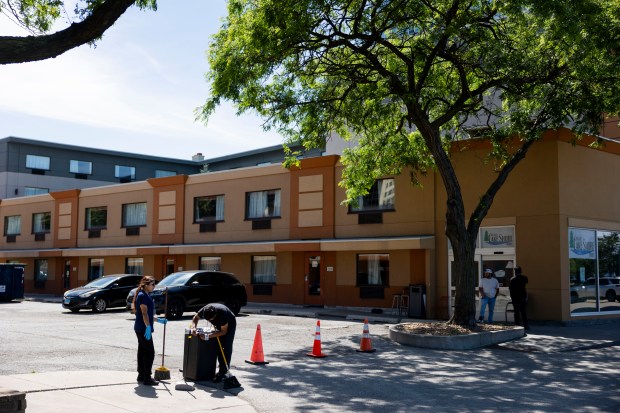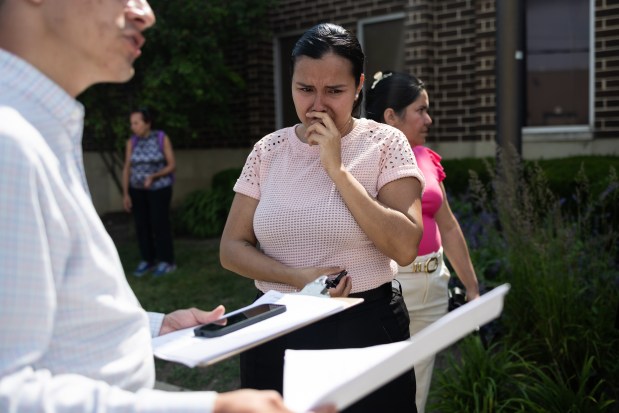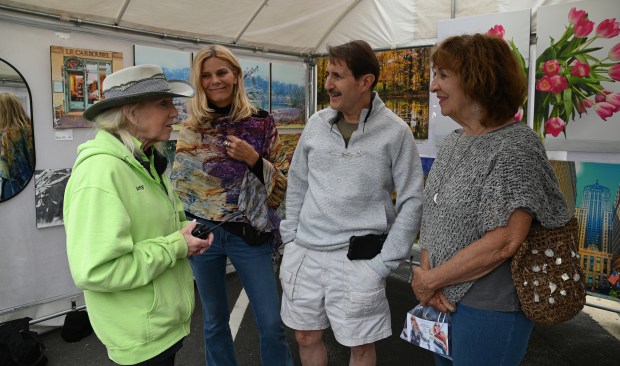Ahead of August’s Democratic National Convention in Chicago, Gov. J.B. Pritzker’s administration this week revealed it’s opening two new shelters to house up to 1,700 migrants, though the governor’s office sought to downplay the timing.
Officials have long raised concerns that Republican Gov. Greg Abbott of Texas might try to sow discord during the DNC by sending a new wave of migrant buses from the southern border. But a Pritzker spokeswoman said the new shelters had been in the works “for some time.”
“I wouldn’t read into the timing,” Pritzker spokeswoman Jordan Abudayyeh wrote in an email. “It’s just when the details worked out.”
But a Democratic state lawmaker whose district is home to one of the new shelters said that when she raised concerns to Pritzker’s Illinois Department of Human Services about the plan to bring up to 950 more migrants to her Southwest Side and southwest suburban area, agency officials specifically referenced the “unpredictability” of what Abbott might do in the lead-up to the political convention.
“That was their reason for it,” Rep. Angelica Guerrero-Cuellar of Chicago said Thursday.
Guerrero-Cuellar and state Sen. Mike Porfirio, a La Grange Democrat who also represents the area, said in a statement this week they only learned Pritzker’s administration was moving forward with its plans after it sent out a news release detailing the shelter openings. During previous discussions about the shelter being located in a former hotel near Midway Airport, the lawmakers had raised numerous questions and public safety concerns.
Work at the property began last week, with plans to begin moving families into the facility in July, according to the Department of Human Services news release.
Prior, the lawmakers had pushed for a town hall meeting to allow the community to weigh in, Guerrero-Cuellar said. She called the administration’s timeline for opening “very aggressive.”
IDHS spokeswoman Daisy Contreras said in a statement that the state changed the shelter’s curfew time in response to Guerrero-Cuellar’s feedback and that state officials have connected with the mayors of adjacent communities to ensure they can reach out with any questions or concerns.
In addition to the planned shelter inside a recently renovated Holiday Inn in the West Lawn neighborhood, state officials also are converting a former Hyde Park hotel into a 750-bed shelter for families. The Hyde Park site had been used to quarantine migrants during a measles outbreak earlier this year.
The state-funded sites, which will be part of the city’s system, are opening as Mayor Brandon Johnson’s administration has been closing shelters and ramping up enforcement of a 60-day limit on stays. But the state is bringing the new sites online just as it closes down an emergency rental assistance program that was available to migrants who arrived before mid-November.
As of Thursday, there were 6,054 people housed in 17 shelters in the city system, including a state-funded facility at a former CVS store in the Little Village neighborhood that can hold up to 300 people. That’s down from 28 shelters that were operating in February.
Once the two new shelters are fully operational, the state will have made good on a promise made in November to provide 2,000 additional beds for migrants as part of a $160 million plan to alleviate bottlenecks in the city’s shelter system that at the time resulted in thousands of people sleeping in and outside of Chicago police stations as winter approached.
City efforts to mitigate that problem with a massive tent encampment in the Brighton Park neighborhood got bogged down in sparring between the Pritzker and Johnson administrations. The governor eventually canceled the encampment plan in early December after his administration cited environmental concerns with the city-selected site.
Johnson’s office did not respond to questions about the state’s recently announced shelter plans.
While arrivals have ebbed in the months since, “past trends indicate an increase in the flow of asylum-seekers from Texas in the summer into the fall and this will ensure we are prepared if that holds true this year,” Pritzker spokesman Alex Gough wrote in an email.
The new shelters are a result of an agreement among the state, city and Cook County announced earlier this year, Gough said, with state funding coming from both the $160 million allotment from November and the $182 million in state spending planned for in the next budget year, which begins Monday.
The shelters, which Gough said will operate at 25% capacity for the first six weeks after opening, are operated by a partnership between private security firm GardaWorld Federal Services and Chicago-based organization New Life Centers. It’s the same arrangement as at the Little Village shelter that opened in January.
Most of the city’s shelters, in contrast, are run by Favorite Healthcare Staffing, which has garnered controversy for its ballooning overtime and strict policies barring mutual aid volunteers from entering. Migrants have told the Tribune that Favorite Staffing shelter workers have rationed goods and used retaliation techniques against migrants for speaking out.
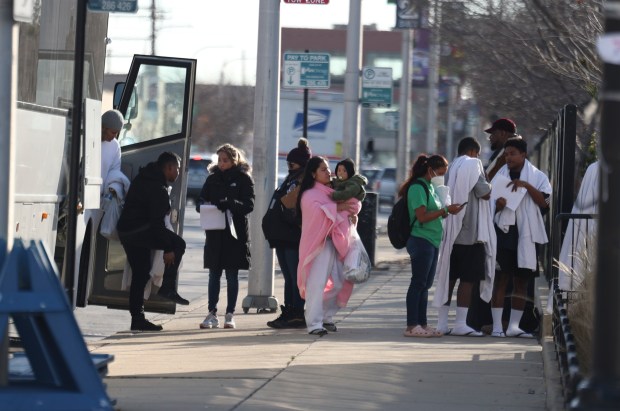
Joanna Dyckman, community navigator lead for New Life Centers, confirmed the organization is more involved in the shelter system than ever before.
Her team currently runs social work services at the shelter in Hyde Park, she said, which started housing asylum-seekers after several families were moved there following a measles outbreak at a migrant shelter on the Lower West Side.
New Life case workers host workshops at the Hyde Park shelter to inform migrants about Chicago culture and answer questions migrants might have about their immigration cases. Dyckman said they arrange movie nights and help migrant children get involved with Chicago public libraries. She said their goal is to make their shelter stay “a little more pleasant,” while GardaWorld handles logistics such as food distribution.
The shelters are opening amid a housing crisis in Illinois, said Bob Palmer, policy director of Housing Action Illinois. He stressed that thousands of migrants have entered the tightest-ever market for low-income renters.
“There’s a huge statewide deficit for shelter beds — including in the city of Chicago — and that was the case even before the increase in demands caused by all the people who are new arrivals,” Palmer said.
The state, while helping fund shelters for migrants in the city, also facilitated an emergency rental assistance program to help people move out of crowded hotels and warehouses. Migrants received three months to six months of rental assistance, mostly settling on the South and West sides where they say rent is more affordable.
That program application portal closed June 16, after distributing about $53 million to help migrants move into more than 6,000 apartments, Contreras said.
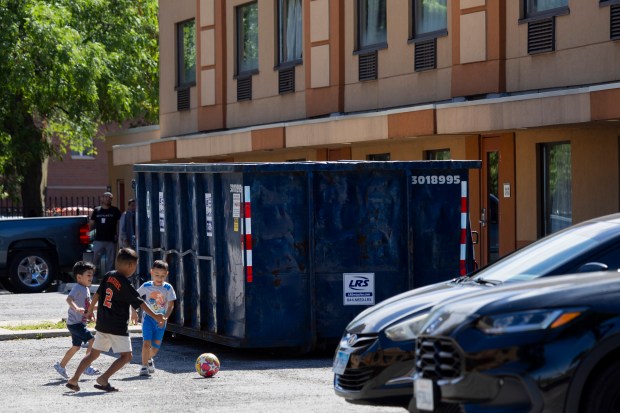
Michelle Gilbert, legal and policy director at Law Center for Better Housing, said that once migrants get to the end of their rental assistance, she anticipates many will find themselves either in eviction court or re-entering shelters.
While there is some state funding that has become available for court-based rental assistance — which arose during COVID-19 — advocates say the 1,700 additional beds provided by the state this summer will help address the possible increase in migrant homelessness that may come following the end of the rental assistance program.
Homeless rates typically rise in the summer, and, ahead of the DNC in August, city and state officials also have publicly acknowledged the potential for a swell of buses sent by Abbott to make political hay about liberal immigration policies as Democrats celebrate President Joe Biden’s renomination.
Officials have yet to detail a plan for how they would respond to a larger-than-usual number of buses arriving in Chicago in late summer.
It’s unclear whether there will be another summer surge of migrants after Biden placed restrictions on the border at the beginning of June. The restrictions came after Congress failed to pass a bipartisan immigration and border security proposal earlier this year.
But the city is still housing hundreds of migrants in downtown locations such as in Streeterville and in the Loop.
The two state-supported shelters are further from downtown and the convention events, which volunteers working with migrants suspect may be an attempt to keep people loitering outside shelters away from the spotlight during the convention.
Naomi Steinberg, vice president of policy and advocacy for the refugee agency HIAS, said Abbott sent people on buses with very little information as a fear-mongering technique.
“It was to make a larger political point at the expense of people who were being used as pawns,” she said.


